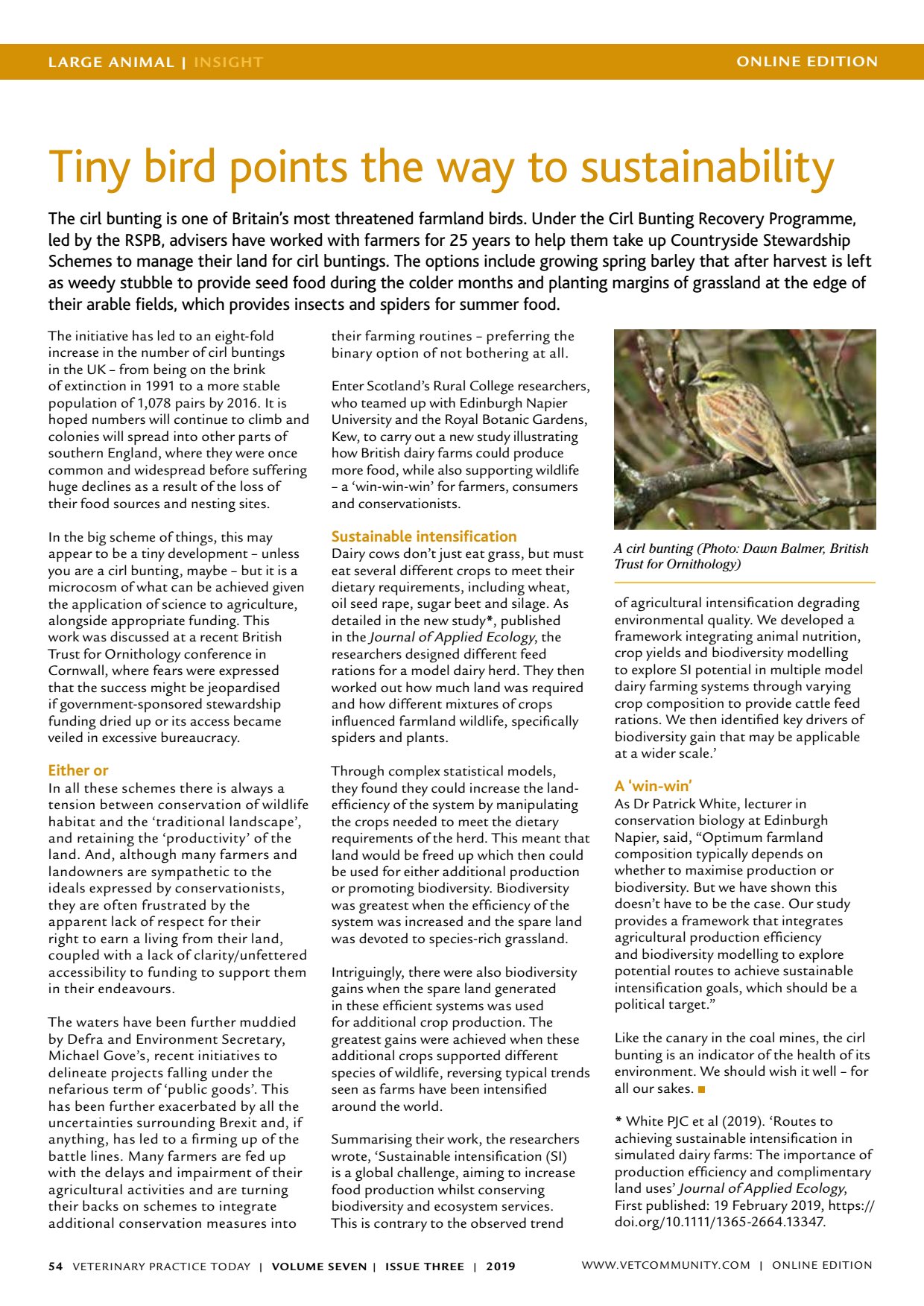Tiny bird points
L ARGE ANIMAL | INSIGHT VETERINARY PRACTICE TODAY | VOLUME SEVEN | ISSUE THREE | 2019 54 Tiny bird points the way to sustainability The cirl bunting is one of Britains most threatened farmland birds. Under the Cirl Bunting Recovery Programme, led by the RSPB, advisers have worked with farmers for 25 years to help them take up Countryside Stewardship Schemes to manage their land for cirl buntings. The options include growing spring barley that after harvest is left as weedy stubble to provide seed food during the colder months and planting margins of grassland at the edge of their arable fields, which provides insects and spiders for summer food. The initiative has led to an eight-fold increase in the number of cirl buntings in the UK from being on the brink of extinction in 1991 to a more stable population of 1,078 pairs by 2016. It is hoped numbers will continue to climb and colonies will spread into other parts of southern England, where they were once common and widespread before suffering huge declines as a result of the loss of their food sources and nesting sites. In the big scheme of things, this may appear to be a tiny development unless you are a cirl bunting, maybe but it is a microcosm of what can be achieved given the application of science to agriculture, alongside appropriate funding. This work was discussed at a recent British Trust for Ornithology conference in Cornwall, where fears were expressed that the success might be jeopardised if government-sponsored stewardship funding dried up or its access became veiled in excessive bureaucracy. Either or In all these schemes there is always a tension between conservation of wildlife habitat and the traditional landscape, and retaining the productivity of the land. And, although many farmers and landowners are sympathetic to the ideals expressed by conservationists, they are often frustrated by the apparent lack of respect for their right to earn a living from their land, coupled with a lack of clarity/unfettered accessibility to funding to support them in their endeavours. The waters have been further muddied by Defra and Environment Secretary, Michael Goves, recent initiatives to delineate projects falling under the nefarious term of public goods. This has been further exacerbated by all the uncertainties surrounding Brexit and, if anything, has led to a firming up of the battle lines. Many farmers are fed up with the delays and impairment of their agricultural activities and are turning their backs on schemes to integrate additional conservation measures into their farming routines preferring the binary option of not bothering at all. Enter Scotlands Rural College researchers, who teamed up with Edinburgh Napier University and the Royal Botanic Gardens, Kew, to carry out a new study illustrating how British dairy farms could produce more food, while also supporting wildlife a win-win-win for farmers, consumers and conservationists. Sustainable intensification Dairy cows dont just eat grass, but must eat several different crops to meet their dietary requirements, including wheat, oil seed rape, sugar beet and silage. As detailed in the new study , published in the Journal of Applied Ecology, the researchers designed different feed rations for a model dairy herd. They then worked out how much land was required and how different mixtures of crops influenced farmland wildlife, specifically spiders and plants. Through complex statistical models, they found they could increase the land- efficiency of the system by manipulating the crops needed to meet the dietary requirements of the herd. This meant that land would be freed up which then could be used for either additional production or promoting biodiversity. Biodiversity was greatest when the efficiency of the system was increased and the spare land was devoted to species-rich grassland. Intriguingly, there were also biodiversity gains when the spare land generated in these efficient systems was used for additional crop production. The greatest gains were achieved when these additional crops supported different species of wildlife, reversing typical trends seen as farms have been intensified around the world. Summarising their work, the researchers wrote, Sustainable intensification (SI) is a global challenge, aiming to increase food production whilst conserving biodiversity and ecosystem services. This is contrary to the observed trend of agricultural intensification degrading environmental quality. We developed a framework integrating animal nutrition, crop yields and biodiversity modelling to explore SI potential in multiple model dairy farming systems through varying crop composition to provide cattle feed rations. We then identified key drivers of biodiversity gain that may be applicable at a wider scale. A win-win As Dr Patrick White, lecturer in conservation biology at Edinburgh Napier, said, Optimum farmland composition typically depends on whether to maximise production or biodiversity. But we have shown this doesnt have to be the case. Our study provides a framework that integrates agricultural production efficiency and biodiversity modelling to explore potential routes to achieve sustainable intensification goals, which should be a political target. Like the canary in the coal mines, the cirl bunting is an indicator of the health of its environment. We should wish it well for all our sakes. White PJC et al (2019). Routes to achieving sustainable intensification in simulated dairy farms: The importance of production efficiency and complimentary land uses Journal of Applied Ecology, First published: 19 February 2019, https:// doi.org/10.1111/1365-2664.13347. A cirl bunting (Photo: Dawn Balmer, British Trust for Ornithology) WWW.VETCOMMUNIT Y.COM | ONLINE EDITION ONLINE EDITION
